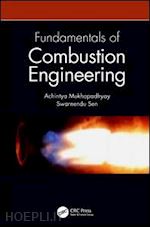Achintya Mukhopadhyay is a Professor of Mechanical Engineering at Jadavpur University, Kolkata (Calcutta), India. He also served as Professor of Mechanical Engineering at Indian Institute of Technology Madras. Dr. Mukhopadhyay also held visiting positions at Technical University of Munich where he was an Alexander von Humboldt Fellow and University of Illinois at Chicago. Dr. Mukhopadhyay’s teaching and research interests include thermodynamics, heat transfer, combustion, multiphase flows and design and analysis of thermal systems. Dr. Mukhopadhyay has over 275 research publications including over 100 international journal publications. Dr. Mukhopadhyay is a Fellow of the West Bengal Academy of Science and Technology and International Society for Energy, Environment and Sustainability and life member of Indian Society of Heat and Mass Transfer and Indian section of the Combustion Institute. Swarnendu Sen is a Professor of Mechanical Engineering at Jadavpur University, Kolkata (Calcutta), India. Dr. Sen held visiting position at Technical University of Munich where he was a DAAD Fellow. He also held visiting positions at University of Illinois at Chicago and Virginia Tech, Blacksburg, USA. He worked in HCL Ltd. and Development Consultants Ltd. as graduate engineer in the area of design and analysis. His area of interest covers reacting & multiphase flow, magnetic fluid & nanofluid transport, heat transfer augmentation and combustion synthesis of carbon nano-structures. Dr. Sen has around 300 research publications including over 100 international journal publications. Dr. Sen is a Fellow of the West Bengal Academy of Science and Technology and International Society for Energy, Environment and Sustainability. He is a life member of Indian section of the Combustion Institute, Indian Society of Heating, Refrigerating and Air Conditioning Engineers and Indian Society of Heat and Mass Transfer.












